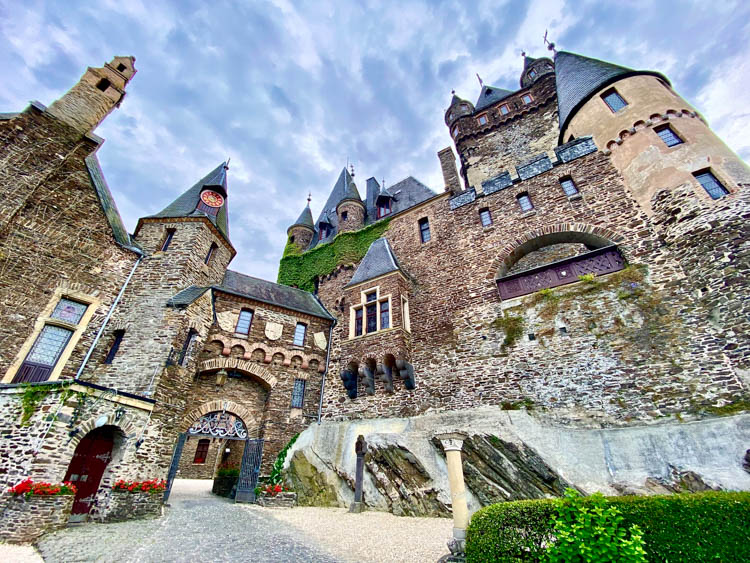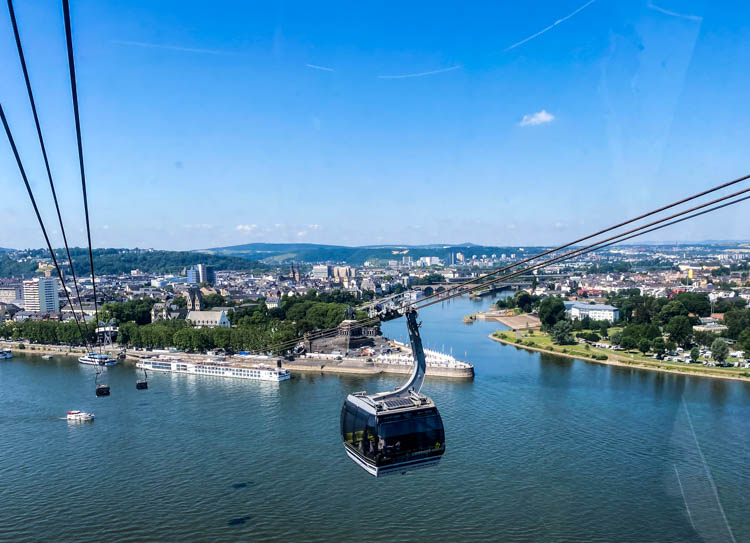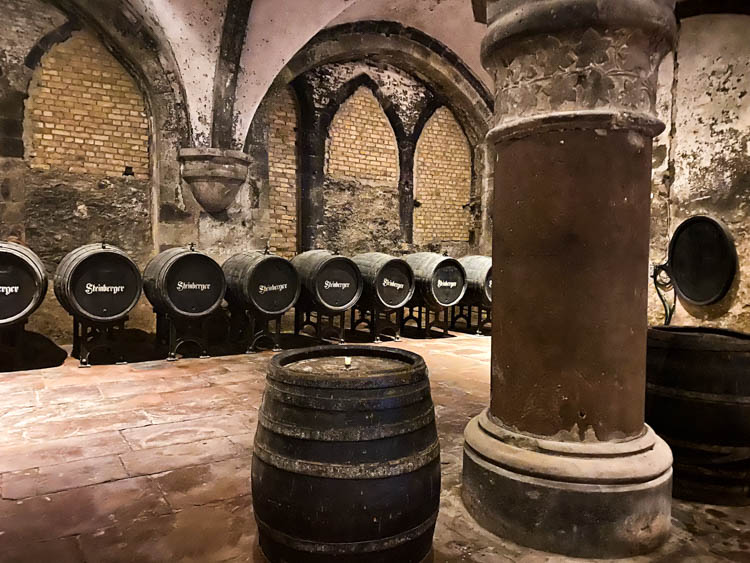
Go World Travel is reader-supported and may earn a commission from purchases made through links in this piece.
Exploring Europe with a river cruise is a bucket list item for many people. It’s a wonderful way to visit various European highlights in a short time. All without the hassle of trains, planes and automobiles. Or having to change hotels.
The Danube and the Rhine tend to be the popular choices for a river cruise in Europe. This is mostly due to stops in hot spots like Budapest, Vienna and Amsterdam.
However, we’re here to share an amazing alternative to those routes. We recently sailed through Germany’s Moselle wine region along the Moselle River with Emerald Cruises and were blown away.
Our Emerald Star-Ship sailed us through the stunningly beautiful and peaceful Moselle Valley where terraced vineyards and quaint towns and villages line the river.
There were far fewer ships cruising the waterway than we’d experienced on the Danube. Plus, of course, the ports and towns were more quaint and laid back than the bustling cities of Budapest and Amsterdam.
Does cruising along a quiet river flanked with vineyards and wineries and stopping at lesser-known, picturesque towns appeal to you? Then you’ll love Emerald’s Moselle and Rhine River Cruise.

Ports of Call on Emerald’s Rhine & Moselle River Cruise
Following are the stops we made on our Rhine & Moselle River Cruise. Take note that cruises also run in the opposite direction and there is also a chance of slight changes due to water height and port traffic.
For the Moselle itinerary, most people will fly in and out of Frankfurt and be transported to and from the ship by luxury coach.

Achingly Beautiful Bernkastel-Kues
We boarded the Emerald Dawn Star-Ship in Bernkastel where we would overnight and spend the following day. Bernkastel is achingly charming and picturesque and was an amazing way to begin our journey.
The full name is Bernkastel-Kues. This reflects the fact that they are actually twin towns on opposite sides of the Moselle River. However, the small medieval village of Bernkastel is where the bulk of the sights are.
Marktplatz is the center of the old town and is full of gabled, timber-framed, colorful buildings dating to the 17th century or earlier. The most notable and photographed building here is the Spitzhäuschen (Pointed House), built in 1416. Pop inside for a delicious glass of local white in the tiny wine bar.

Other highlights of Bernkastel include the 13th century Rathaus (Town Hall) with its lovely Baroque roof. Also, the Graach Gate which dates to 1300 and is the last surviving city gate.
Plus the hilltop Landshut Castle and Roman ruins. Emerald provided a morning walking tour of Bernkastel with a wine tasting. The Emerald Active option was a bike tour of the surrounding area and vineyards.
The wine tasting was set in a wine cave which added some cool ambiance to the experience. Moselle Valley is known for their superior rieslings of which we tried three. Despite all three wines being the same varietal, they were unique, ranging from fairly dry to sweet and fruity.

Germany’s Oldest City of Trier
From Bernkastel, we glided slowly southwest along the winding Moselle River toward our next stop of Trier. We passed lovely scenery along the way, including impossibly steep vineyards. This was the beginning of our unexpected love affair with the gorgeous Moselle Valley.
The Roman city of Trier is Germany’s oldest city and was founded in 16 BC. It also contains no less than eight UNESCO World Heritage Sites. Yet, Trier is not high on the tourist radar. We think this makes it an even better place to visit.
Trier is nicknamed “Rome of the North” due to the number of Roman remains and monuments. Interesting Roman sights include ancient baths, an amphitheater and the massive Porta Nigra (Black Gate). This is the only remaining gate of the original four and it survived because it became a church.

Our favorite sights in Trier were the Cathedral of St Peter & Church of Our Lady and the city’s heart of Hauptmarkt (Main Market). The cathedral is the oldest church in Germany and is an architectural wonder. The structure displays 1,700 years of mixed styles from Romanesque to Baroque and Gothic.
Hauptmarkt is the largest and busiest square in the city and is a gathering point for locals and visitors. Like the cathedral, there is a mix of architectural styles. The beautiful colorful buildings and market stalls make it feel like an elaborate movie set.

Cochem and the “Sleeping Beauty of the Moselle”
Cochem was the busiest day of our Moselle River Cruise. We did the Emerald Active excursion by bicycle in the morning. In the afternoon we explored the town of Cochem, followed by a visit to Reichsburg Castle that evening.
The active and scenic excursion took us cycling along the Moselle past more steep vineyards. Ultimately we arrived at the quaint village of Beilstein. We saw immediately why it’s known as the “Sleeping Beauty of the Moselle.” It is both stunningly beautiful and blissfully sleepy.

Beilstein is compact but hilly, walkable but a bit strenuous. There is a former monastery-turned-catholic-church and a castle sitting high behind the town offering spectacular views. We hiked up to the old monastery and enjoyed the view with a refreshing beer at the cafe.
After lunch on the ship, we explored lovely Cochem on our own. The Old Town oozes charm and fairy-tale cuteness. We were enthralled with its colorful timber-framed overhanging buildings, medieval clock towers and fountains. Plus the inviting cafes perfect for people watching.

Finding the old stone gates, strolling the Moselle Promenade, shopping for souvenirs, riding the Wine Express Train or taking the cable car up Pinner Kreuz mountain are other things to do in Cochem.
But the highlight is the hard-to-miss, Reichsburg Castle looming over the town and the river. Emerald had arranged a private after-hours tour of the 11th-century castle that evening.
The fairy-tale castle we see today is not the original structure that was mostly destroyed in 1689. It sat in ruins for almost 180 years until a wealthy businessman bought it and had it rebuilt as his family residence in a neo-Gothic style.

The German Corner at Koblenz
The 2,000-year-old city of Koblenz was our last stop along the Moselle before switching to the Rhine. This is where the Rhine and the Moselle converge and it’s known as the German Corner (Deutsches Eck). At this corner is an impressive memorial to Kaiser Wilhelm I and it’s also the site for festivals and events.
Other notable things to do in Koblenz are to wander the lovely Old Town (Aldstadt) and explore the Ehrenbreitstein Fortress. The fortress overlooks Koblenz from atop a hill and the best way to get there is by cable car. The cable car is also a great way to get a birds-eye view of the German Corner.
The Emerald excursion from Koblenz was a visit to the 12th-century Marksburg Castle. This magnificent castle is the only one on the Rhine that was never destroyed. There were some additions in the 17th and 18th centuries but otherwise, it remains as it was built over 1,000 years ago.
You can only visit the castle by tour where you will be shown things like the Gothic Hall, the Knight’s Stairway, the Romanesque Residential Apartments, The Great Battery, a dungeon, a torture room and more.
One personal favorite thing in the castle was the beautiful medieval paintings in the dining hall and castle chapel. The color and detail of these well-preserved paintings is incredible.

Cruising the Middle Rhine to Rüdesheim
From Koblenz, we left the Moselle River and began our cruise through the super scenic Middle Rhine Valley. This stretch is part of a UNESCO site and is dotted with dozens of picturesque castles and fortresses, more quaint riverside towns and slightly less steep vineyards.
There are also areas of narrows created by the transitions of sandstone and clay-slate. The most famous is the Loreley where the fable says a beautiful siren caused the drowning of many a sailor.
In Rüdesheim there is a cable car that will carry you over the vineyards to the massive Niederwald Monument. It sits in Niederwald Park which is a lovely, peaceful setting worth taking some time to enjoy. The Emerald Active option was to hike up through the vineyards to the monument.
Our favorite part of Rüdesheim was the Drosselgasse. This narrow, cobblestone street is full of lovely timber-framed buildings housing restaurants, wine bars, cafes and boutique shops. We enjoyed an evening here listening to music, sipping wine and indulging in a Rudesheimer Kaffee.

The Emerald excursion here was to the Eberbach Abbey. This very well-preserved medieval monastery was founded in 1136 and became one of the busiest in Germany and had the largest vineyard in the country.
Today, it is open for guided tours and has been a filming site for the movie “In the Name of the Rose” and scenes from Game of Thrones.
We had a fabulous guide for our tour who kept us entertained and educated with tales of the ancient monastery both then and now. One of our favorite places there was the dark and atmospheric wine cellars.

The City of Wiesbaden
We spent our final full day in the city of Wiesbaden which was quite a departure from the charming small towns we had visited up to this point. It is one of the oldest spa towns in Europe and at one time had 26 hot springs flowing although the number is now about half that.
Tourists usually visit Wiesbaden for the architecture and spas. But there is also a casino, some lovely parks, good shopping and a water-powered funicular that transports you to the views on top of Neroberg Hill.
To be honest, Wiesbaden was our least favorite stop. However, that’s not necessarily a reflection on the city itself. It’s mostly due to the fact that we had fallen in love over and over again with the gorgeous small towns and epic scenery along the Moselle and Middle Rhine. So it would be tough for any big, busy city to compare to the romantic charm we had experienced for the past 7 days.

Final Thoughts on a Moselle River Cruise
If you have never done a European river cruise, the Moselle Valley may not be at the top of your list. It doesn’t have showstopper capital cities on the itinerary. The river isn’t immortalized in song like the Danube.
However, what it does offer is an almost dreamlike experience of gliding on a peaceful river, dotted with the most charming towns you’ll ever see. All are surrounded by incredible vineyards climbing the steep riverside hills topped with fairy tale castles.
You will also come away with the joyous feeling of having explored a little more off the beaten path. Plus, the realization that there is more to see in Germany than the vibrant cities of Berlin and Munich or the cute towns of Bavaria.
Best Tips & Tools to Plan Your Trip
Author Bio: Sarah and her husband are full-time travelers who run several travel and lifestyle websites including the international travel site Live Dream Discover. She caught the travel bug early in life and eventually created a location-independent business that supports her passion to explore the world. As a writer, editor, photographer and social media expert Sarah is able to share her experiences and insights which inspire people to find their own passion for travel.
- Fiddle, Flutes & Pubs: A Musical Journey Through Northern Ireland & County Donegal - July 14, 2025
- Tokyo vs. Osaka: The Ultimate Face-Off for First-Time Visitors to Japan - July 14, 2025
- When Is the Best Time to Visit Iceland? Find Your Perfect Month for Budget, Weather, and Activities - July 14, 2025

